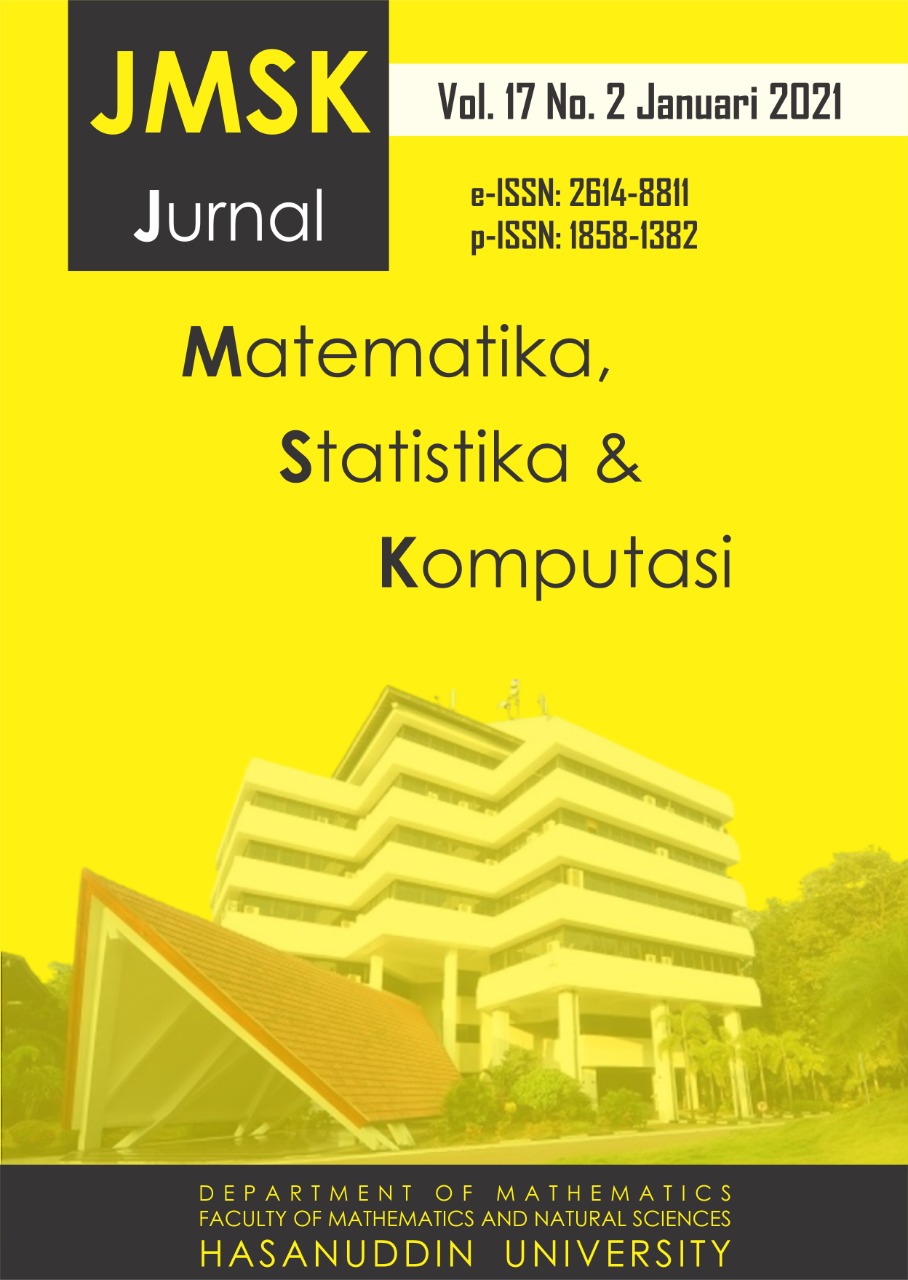Bicluster CC Algoritm Analysis to Identify Patterns of Food Insecurity in Indonesia
DOI:
https://doi.org/10.20956/jmsk.v17i2.12057Keywords:
Biclustering, CC, Algoritm, Food InsecurityAbstract
Indonesia is known as an agricultural country. This means that most of the population work in the agricultural sector related to food. However, food insecurity still occurs in Indonesia. With the COVID-19 pandemic, the Food and Agriculture Organization (FAO) stated that there was a threat of food scarcity which had an impact on food insecurity conditions. This would undermine the second goal of the SDGs, which is to end hunger and create sustainable agriculture. The purpose of this study was to determine the spatial pattern of food insecurity in each province in Indonesia using the bicluster method. The data used are data from Susenas and Sakernas by BPS in 2019. Several studies show that the bicluster method with the CC algorithm shows that each province group has a different characteristic pattern. In the bicluster approach, the researcher runs parameter tuning to select the best parameter based on the Mean Square Residual in Volume (MSR / V). The CC algorithm tries to get a bicluster with a low MSR value, therefore the best parameter is the one that produces the smallest MSR / V value, in this study the smallest MSR / V is 0,01737 with δ = 0,01. The application of the CC biclustering algorithm to the food insecurity structure in Indonesia results in 5 bicluster. Bicluster 1 consists of 15 provinces with 8 variables, Bicluster 2 consists of 10 provinces with 5 variables, Bicluster 3 consists of 3 provinces with 7 variables, Bicluster 4 consists of 4 provinces with 4 variables and Bicluster 5 consists of 2 provinces with 5 variables. Biculster 4 represents a cluster of food insecurity areas with the characteristics of the bicluster P0, P1, P2 and calorie consumption of less than 1400 KKAL.
References
Badan Ketahanan Pangan. 2019. Peta Ketahanan Pangan (Food Security and Vulnerability Atlas). Publikasi. Kementerian Pertanian. Jakarta. Sumber: http://bkp.pertanian.go.id/
Badan Pusat Statistik. 2016. Potret Awal Tujuan Pembangunan Berkelanjutan (Sustainable Development Goals) di Indonesia. Jakarta. Sumber: www.bps.go.id/publication/
Badan Pusat Statistik. 2019. Indikator Tujuan Pembangunan Berkelanjutan (TPB) Indonesia. Jakarta. Sumber: https://www.bps.go.id/indicator.
Badan Pusat Statistik. 2020. BRS Pertumbuhan Ekonomi Indonesia Triwulan III-2020. Jakarta. Sumber: https://www.bps.go.id/pressrelease/2020/11/05/1738/ ekonomi-indonesia-
triwulan-iii-2020-tumbuh-5-05-persen--q-to-q-.html.
Badan Pusat Statistik. 2020. BRS Profil Kemiskinan Di Indonesia Maret 2020. Jakarta. Sumber: https://www.bps.go.id/pressrelease/2020/07/15/1744/persentase-penduduk-miskin-maret-2020-naik-menjadi-9-78-persen.html.
Cafiero, C., Viviani, S. and Nord, M., 2018. Food security measurement in a global context: The food insecurity experience scale. Measurement, 116, pp.146-152.
Chakraborty, A. and Maka, H. 2005. Biclustering of gene expression data using genetic algorithm. In 2005 IEEE Symposium on Computational Intelligence in Bioinformatics and Computational Biology (pp. 1-8). IEEE.
Frongillo, E.A., Nguyen, H.T., Smith, M.D. and Coleman-Jensen, A., 2019. Food Insecurity Is More Strongly Associated with Poor Subjective Well-Being in More-Developed Countries than in Less-Developed Countries. The Journal of Nutrition, 149(2), pp.330-335.
Gundersen, C. and Ziliak, J.P., 2015. Food insecurity and health outcomes. Health affairs, 34(11), pp.1830-1839.
Irawan, Heru. 2019. Faktor-Faktor Rumah Tangga Yang Mencirikan Tingkat Kerawanan Pangan. Thesis. IPB University. Bogor. Sumber : https://repository.ipb.ac.id/
Kaban, Puspita Anggraini, Robert Kurniawan, Rezzy Eko Caraka, Bens Pardamean, and Budi Yuniarto. 2019. Biclustering Method to Capture the Spatial Pattern and to Identify the Causes of Social Vulnerability in Indonesia: A New Recommendation for Disaster Mitigation Policy. Procedia Computer Science 157:31–37.
Kaiser, S., 2011. Biclustering: methods, software and application . Doctoral dissertation. Universitas Ludwig Maximilian. Munich.
Lailatusysyukriyah, L. 2015. Indonesia dan Konsepsi Negara Agraris. Junrnal Seuneubok Lada 2(1):1–8. Universitas Samudra. Langsa.
Paslakis, Georgios, Gina Dimitropoulos, and Debra K. Katzman. 2020. A Call to Action to Address COVID-19–Induced Global Food Insecurity to Prevent Hunger, Malnutrition, and Eating Pathology. Nutrition Reviews. Sumber : https://doi: 10.1093/nutrit/nuaa069
Purwantini, Tri Bastuti. 2016. Pendekatan Rawan Pangan Dan Gizi: Besaran, Karakteristik, Dan Penyebabnya. Jurnal Kementerian Pertanian Republik Indonesia. Jakarta. Sumber : https://repository.pertanian.go.id
Putri, Christiana Anggraeni dan Rini Irfani. 2020. Recognizing Poverty Pattern In Central Java Using Biclustering Analysis. International Conference On Mathematics, Statistics and Data Science (ICMSDS). IPB University. Bogor.
Smith, Michael D., Woubet Kassa, and Paul Winters. 2017. Assessing Food Insecurity in Latin America and the Caribbean Using FAO’s Food Insecurity Experience Scale. Food Policy 71:48–61.
Yuniarto, Budi, and Robert Kurniawan. 2017. Understanding Structure of Poverty Dimensions in East Java: Bicluster Approach. Signifikan: Jurnal Ilmu Ekonomi 6(2):289–300.
Downloads
Published
How to Cite
Issue
Section
License
Copyright (c) 2020 Author and publisher

This work is licensed under a Creative Commons Attribution 4.0 International License.

This work is licensed under a Creative Commons Attribution 4.0 International License.
Jurnal Matematika, Statistika dan Komputasi is an Open Access journal, all articles are distributed under the terms of the Creative Commons Attribution License, allowing third parties to copy and redistribute the material in any medium or format, transform, and build upon the material, provided the original work is properly cited and states its license. This license allows authors and readers to use all articles, data sets, graphics and appendices in data mining applications, search engines, web sites, blogs and other platforms by providing appropriate reference.







